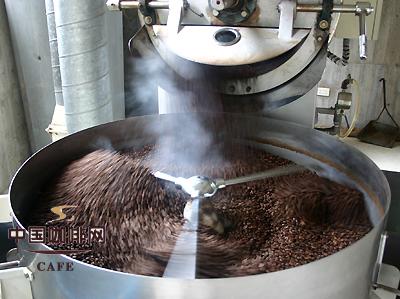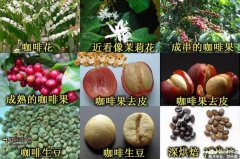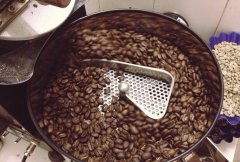Coffee roasting boutique Coffee Learning Coffee Baking knowledge

Roasting: this heat treatment causes significant chemical and physical changes in the structure and composition of raw coffee, causing the beans to darken and emit the characteristic aroma of roasted coffee.
1. The purpose of coffee roasting
The main purposes of coffee roasting are: a, aroma; B, increase the complexity of coffee; C, get color; D, form the unique flavor of coffee and so on.
2. The way coffee is roasted
According to the baking time, it can be divided into two types: fast baking and slow baking. According to the baking machine, it is divided into two types: family workshop type and industrial type. We mainly know about industrial baking.
Project
fast
Slow speed
Baking machine
Hot gas stove, also known as flow bed (HOT AIR ROASTER)
The beans are baked by a vortex formed by a high-temperature air. due to the strong air flow, the coffee beans are constantly blown up and suspended in the furnace without the need for metal blades to stir.
Roller furnace, also known as roller type (DRUM ROASTER)
When the gas is heated through the bottom of the furnace, the coffee beans are gradually heated by the air, and the metal blades in the furnace keep stirring the beans.
time
As short as 90 seconds (traditional time is 12 minutes)
Up to 40 minutes (traditional 12 minutes)
Production scale
Large, high output, about 1500-4000 kg / h.
Small, low output, about 700 kg / h.
Advantages
The strong hot air conducts heat well, and the coffee beans are heated more evenly, and the desired baking degree can be achieved in the shortest time, thus reducing the disappearance of coffee oil and cell tissue damage, and the baking time is mostly within three to eleven minutes. Due to the short time, the weight loss of coffee beans is less, which can save money, so most of the people who use this processing method are large companies.
Just start baking at a warm heat, and then slowly increase the heat after an explosion, so as to prevent the water in the beans from evaporating too quickly and minimize the damage to the cell and tissue. Only by heating step by step can the flavor of coffee beans be fully displayed.
Areas with poor economic conditions usually use long-term baking because most consumers can only afford low-cost, defective coffee beans.
Shortcoming
Without sufficient reaction time, the residue of polyphenols leads to a metallic bitterness. At the same time, due to high-speed processing, volatile aroma molecules are not formed.
Baking for a long time can drive out the bad taste and smell. But the favorite smell and aroma are also gone.
Flavor
Sour taste is more obvious, more layered.
It suppresses the sour taste and the taste is low and sweet.
Chlorogenic acid
There are many residues.
Less residue
3. The roasting process of coffee
The first stage of baking is endothermic, in which raw coffee beans are slowly dried until they change to a yellowish color, and the baking smells like toast or popcorn.
The second stage, commonly known as the first crack, usually occurs at about 205C, during which the coffee beans double in size, change to a light brown color and lose about 5 per cent of their weight.
The third stage is the first explosion to the second explosion, the temperature rises from 205 degrees Celsius to about 220 degrees Celsius, the color changes from light coffee to moderate coffee, and the weight loss is about 13%. This chemical process is called pyrolysis, which converts the chemical composition of coffee beans and releases carbon dioxide. The third stage is the second endothermic period, followed by the second exothermic period (exothermic), called the second explosion (second crack). The second pyrolysis takes place at about 225-230 degrees Celsius, baking a medium-deep brown color, and the sound of the second explosion sounds dense and fast, and the surface of the coffee bean is covered with a layer of oil.
In the process of segmented heating in a bean dryer (usually using a large, hot rotating cylinder), the remaining water in the coffee bean cells turns into steam, prompting the rich carbohydrates, proteins, lipids and minerals to undergo a variety of complex chemical reactions. Coffee beans begin the caramelization process between 170C and 200C. At 185240C, carbohydrates combine with amino acids, peptides and proteins for caramelization, also known as the Mena reaction (maillard's reaction).
Caramelization is one of the most important factors affecting the flavor of coffee. After baking for 6-7 minutes, raw beans absorb a lot of heat and start the pyrolysis reaction.
Pyrolysis can last until the second explosion, although caramelization is an important process to awaken the aroma of coffee, but with the extension of baking time, some ingredients will also be carbonized to form a bad astringent bitter substance, how to get the highest caramelization. At the same time, carbonization should be reduced to the lowest point, which is the highest technical link of roasting coffee beans.
During the roasting process, the volume of coffee beans increases by at least half, while the weight of beans decreases by 1. 5%.
Important Notice :
前街咖啡 FrontStreet Coffee has moved to new addredd:
FrontStreet Coffee Address: 315,Donghua East Road,GuangZhou
Tel:020 38364473
- Prev

Fine Coffee basic knowledge of Coffee Coffee growth process
1. Seed selection, seedling planting, shaping, pruning, soil management, fertilization, pest control, flowering and fruit picking. 2. Picking can be divided into two ways: manual picking and mechanical picking. Manual picking is divided into two ways: daylighting and selective picking. High quality coffee beans can be obtained by picking.
- Next

Roasting knowledge of coffee beans
According to the color standard and caramel degree, coffee can be divided into the following roasting methods
Related
- Beginners will see the "Coffee pull flower" guide!
- What is the difference between ice blog purified milk and ordinary milk coffee?
- Why is the Philippines the largest producer of crops in Liberia?
- For coffee extraction, should the fine powder be retained?
- How does extracted espresso fill pressed powder? How much strength does it take to press the powder?
- How to make jasmine cold extract coffee? Is the jasmine + latte good?
- Will this little toy really make the coffee taste better? How does Lily Drip affect coffee extraction?
- Will the action of slapping the filter cup also affect coffee extraction?
- What's the difference between powder-to-water ratio and powder-to-liquid ratio?
- What is the Ethiopian local species? What does it have to do with Heirloom native species?

